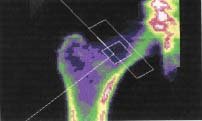Understanding your dexa scan results
You have your Dexa scan results You have T score numbers and Z score numbers.
You have pluses ( + ) and/or minuses ( - ) and you have been diagnosed with Osteopenia or Osteoporosis But it may seem a bit confusing. What does it all mean?
You can understand your dexa scan results. And understanding those results is important if you are serious about strengthening your bones. You need to understand exactly where you are NOW if you want to plan to be somewhere else in a year or so.
So let's get to the details.
Ask for a copy of your test results. If You have not done so already, call your health care provider and ask for a copy, a print out of your dexascan results AND any accompanying images.
It really helps to see the images since the light spots will show you where you have a lack of bone density. Very motivating!
I always ask my health care provider for a copy so I can study it at
home. And I file my copies so I can compare results from year
to year. I find it very motivating to see my results and I review at these papers a few times a year to keep me motivated because I know that so much of building new bone depends on me and my actions (not just some prescription drug).
Also, I know my health care provider has my best interests at heart but I figure I need time to study my own health
records. Sometimes reviewing them at home helps me figure out what
questions to ask at my next appointment.
But you want to know how to read the dexascan report - what it all means.
1. The column marked BMD gives your bone mineral density - the number of grams per centimeter of bone. Numbers of +1.0 or above are good.
2. The column marked T score shows how your bone mineral density compares with women in their thirties, the peak bone density years. when it is highly unlikely that you would suffer a fracture. Scores of +1.0 are good. Numbers between +1 and - 1 show normal bone mineral density.

Scores between -1 and -2.5 indicate Osteopenia (thin bones).
Less
than -2.5 indicate Osteoporosis (porous bones) , eg. - 2.7, -3.0 etc.
And -3.0 shows serious Osteoporosis.
3. The column marked Z score compares your bone mineral density with others of your own age.
Now, you may be thinking, "Well I am OK when compared with people my own age. Why should I care how I compare with some 30 year old? "
That is exactly what I thought when I saw my first dexa scan results. I figured, "My Z scores shows that I have better bone density that most of the women my age. Why should I worry about the T score." Boy that was a mistake - as I figured out later.
When I began to research the history of dexa scans and Osteopenia and Osteoporosis fracture I realized that the T score was very important.
Why? Because most of us reach peak bone mass in our thirties. Our bones are at their strongest and
least likely to fracture. Those in their thirties are less
likely to break a hip in a fall or have a vertebra collapse spontaneously. (Which leads to dowagers hump.)
What good does it do us to have bones as strong as those in our age group ( the Z score), if our age group is showing a 40 or 50% fracture rate? The day I realized that it did me NO GOOD to be as good as most women my age..... when most women my age were at high risk for fractures is the day I began to understand the importance of improving my T score.
Since that day, I have paid little attention to my Z scores. My aim has been to increase my BMD score and my T- score! And I am happy to say that I have done that. My last dexa scan showed NORMAL bone density!
You
can increase your bone density too. This web site is filled with
information about ways to do it. (Suggestion: Start by getting clear as
to why you have Osteopenia or Osteoporosis. Then you can make a plan
that best fits your circumstances. See: Causes of bone loss )
If you would like to understand even more about your dexa scan and how technicians read it, The University of Washington offers material for for technicians. You can view their tutorial about Dexa Scans .
Here is a YouTube video about dexa scans

